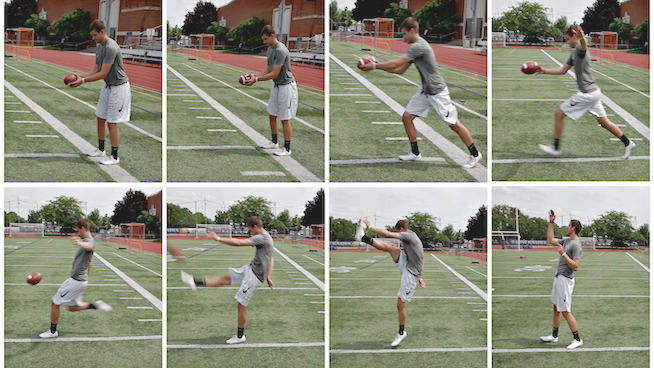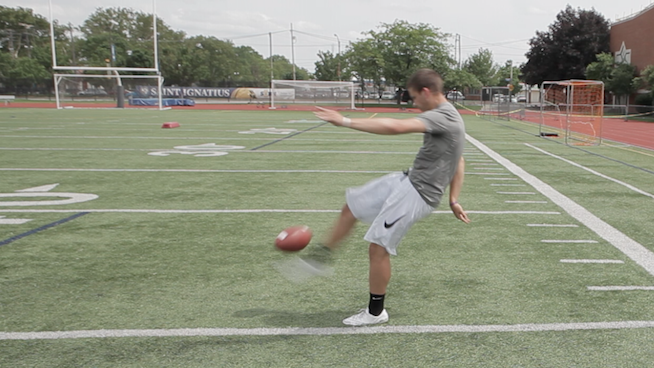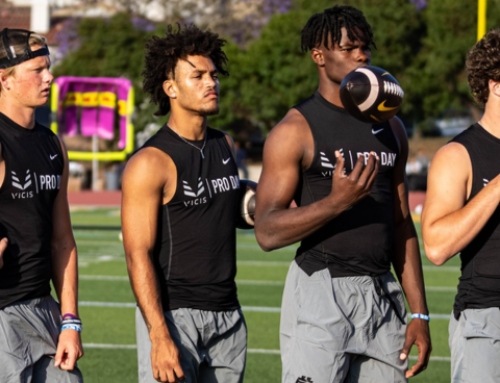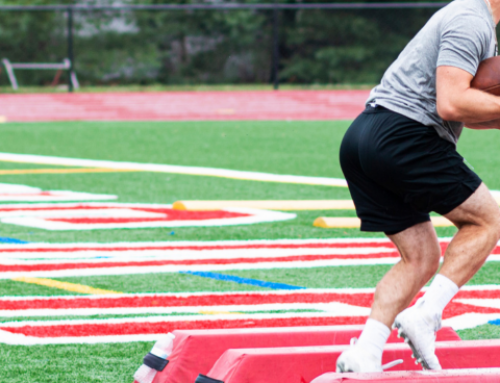How to Punt a Football: A Step-by-Step Photo Guide
Although it might occasionally get overlooked, punting plays a huge role in football. A good punter can dramatically alter his team’s field position and force an opposing offense to gain a large amount of yardage before getting into scoring range.
As such, punting is a valuable skill. Even if you primarily play an offensive or defensive position, knowing how to punt can help you get on the field more frequently and help your team win more games. If you’re a player or coach who wants to learn the fundamentals of punting a football, check out these eight simple steps.
The 8 Steps of Punting
Shown above are the eight steps of punting a football. Let’s dive in to each to showcase the basic fundamentals of punting.
1. Catch and Secure the Ball
This is one of the most important aspects of punting. You can’t punt the ball until you catch it, and dropping the ball or letting it get past you can be disastrous. You don’t want to be this guy.
Start in an athletic stance with your feet about shoulder-width apart and your knees bent slightly. The foot you will punt with should be a few inches in front of the opposite foot. If possible, you want to catch the ball directly in front of your chest, but be prepared to move if there’s an errant snap.
The key things to remember are to keep your hands together while you’re preparing to catch the ball and to catch the ball with your hands and not your body.
2. The Grip/Laces Up
There’s a good chance that when you catch the ball, it won’t be exactly where you want it. Ideally, the ball will be extended in front of you just below your chest. The laces must face straight up when you punt, so you will probably have to rotate the ball after you catch it.
How you grip the ball is another important aspect of punting. One of the most basic grips, the “handshake” grip, is illustrated in the photo above. It requires you to hold the ball like you’re shaking a hand.
Grip the ball with the hand on the same side as the foot you will punt with. Place your middle finger on one side of the the seam and your thumb on the other. Hold the ball with your fingertips so the back tip does not contact your palm. Place your opposite hand softly on the underside of the ball for additional support. Don’t hold the ball with the point sticking straight out in front of you. Hold it with the front tip angled slightly away from your kicking foot. It’s not a drastic change—if you’re right-footed, the tip will be pointing to about 11 o’clock. More on this later.
These are just guidelines. You can adjust your grip to whatever you find most comfortable. There are many other types of grips, but the handshake grip is a good one for beginners.
3. The Stab Step
Once you’ve caught the ball and positioned it correctly with a good grip, it’s time to start the actual punting process. Take your first step with your kicking foot. This step is short and quick, covering no more than a yard in front of you. It’s sometimes called a “stab step.” The reason it’s short is because a long, lunging step can throw off your center of gravity. A short first step allows you to keep your feet underneath you and have good body control as you move through the punt.
4. The Drop
After your stab step, move directly into your second step. This will cover more ground than your first step and help you generate momentum into the punt.
As you take your second step, simultaneously remove your support hand from the football, leaving just your “handshake” grip. Drop the ball by simply opening your hand and loosening your grip. Don’t throw the ball or push it down—simply let it drop. Ideally, the ball should drop straight down. If you didn’t kick it, the ball would hit flush against the turf and bounce straight back up. If the ball tumbles when you drop it, you’re setting yourself up to miss the sweet spot and kick a tip. The drop is a crucial part of punting and you can practice it anywhere.
The drop is the reason why you hold the ball at a slight angle. If you didn’t angle the ball, when you drop it straight down, the tip could hit your shin, causing the ball to rotate before you kick it—and you would miss the sweet spot. By angling the ball to the side when you drop it, you give your leg a clear path to the ball’s sweet spot.
5. The Plant
The plant occurs when your second step hits the ground. A good, stable plant allows you to deliver a powerful, accurate punt. Your plant foot should be in front of your hips as you lean back to drive your foot through the ball. By the time your plant foot is on the ground, the ball should be leaving your hand.
6. Contact
Contact is critical to a successful punt. If your drop is good and your fundamentals are solid, you’ll be in position to make great contact. Aim the the top of your foot to hit the “belly” of the football, directly opposite the laces.
Don’t stop driving your leg when your foot contacts the ball. Drive your foot through the ball to ensure maximum power and distance.
7. The Follow-Through
Drive your leg up toward your head with your follow-through. To stabilize yourself, you can hold your arms out in front of you. Your follow-through might be so forceful that your plant foot leaves the ground. This is to be expected.
8. The Finish
Finish with both feet back on the ground and your head tilted up to follow the ball. You’re likely the only player on your team with a clear view of where the ball is headed, so your job is to tell your teammates. Part of this depends on your coach’s game plan and whether you intended to kick the ball in a certain direction or to a certain spot on the field.
Every punter has his own style, but these fundamentals should give you what you need to become a great punter. Feel free to experiment with small changes until you find the exact punting style that’s most effective for you.
READ MORE:
RECOMMENDED FOR YOU
MOST POPULAR
How to Punt a Football: A Step-by-Step Photo Guide
Although it might occasionally get overlooked, punting plays a huge role in football. A good punter can dramatically alter his team’s field position and force an opposing offense to gain a large amount of yardage before getting into scoring range.
As such, punting is a valuable skill. Even if you primarily play an offensive or defensive position, knowing how to punt can help you get on the field more frequently and help your team win more games. If you’re a player or coach who wants to learn the fundamentals of punting a football, check out these eight simple steps.
The 8 Steps of Punting
Shown above are the eight steps of punting a football. Let’s dive in to each to showcase the basic fundamentals of punting.
1. Catch and Secure the Ball
This is one of the most important aspects of punting. You can’t punt the ball until you catch it, and dropping the ball or letting it get past you can be disastrous. You don’t want to be this guy.
Start in an athletic stance with your feet about shoulder-width apart and your knees bent slightly. The foot you will punt with should be a few inches in front of the opposite foot. If possible, you want to catch the ball directly in front of your chest, but be prepared to move if there’s an errant snap.
The key things to remember are to keep your hands together while you’re preparing to catch the ball and to catch the ball with your hands and not your body.
2. The Grip/Laces Up
There’s a good chance that when you catch the ball, it won’t be exactly where you want it. Ideally, the ball will be extended in front of you just below your chest. The laces must face straight up when you punt, so you will probably have to rotate the ball after you catch it.
How you grip the ball is another important aspect of punting. One of the most basic grips, the “handshake” grip, is illustrated in the photo above. It requires you to hold the ball like you’re shaking a hand.
Grip the ball with the hand on the same side as the foot you will punt with. Place your middle finger on one side of the the seam and your thumb on the other. Hold the ball with your fingertips so the back tip does not contact your palm. Place your opposite hand softly on the underside of the ball for additional support. Don’t hold the ball with the point sticking straight out in front of you. Hold it with the front tip angled slightly away from your kicking foot. It’s not a drastic change—if you’re right-footed, the tip will be pointing to about 11 o’clock. More on this later.
These are just guidelines. You can adjust your grip to whatever you find most comfortable. There are many other types of grips, but the handshake grip is a good one for beginners.
3. The Stab Step
Once you’ve caught the ball and positioned it correctly with a good grip, it’s time to start the actual punting process. Take your first step with your kicking foot. This step is short and quick, covering no more than a yard in front of you. It’s sometimes called a “stab step.” The reason it’s short is because a long, lunging step can throw off your center of gravity. A short first step allows you to keep your feet underneath you and have good body control as you move through the punt.
4. The Drop
After your stab step, move directly into your second step. This will cover more ground than your first step and help you generate momentum into the punt.
As you take your second step, simultaneously remove your support hand from the football, leaving just your “handshake” grip. Drop the ball by simply opening your hand and loosening your grip. Don’t throw the ball or push it down—simply let it drop. Ideally, the ball should drop straight down. If you didn’t kick it, the ball would hit flush against the turf and bounce straight back up. If the ball tumbles when you drop it, you’re setting yourself up to miss the sweet spot and kick a tip. The drop is a crucial part of punting and you can practice it anywhere.
The drop is the reason why you hold the ball at a slight angle. If you didn’t angle the ball, when you drop it straight down, the tip could hit your shin, causing the ball to rotate before you kick it—and you would miss the sweet spot. By angling the ball to the side when you drop it, you give your leg a clear path to the ball’s sweet spot.
5. The Plant
The plant occurs when your second step hits the ground. A good, stable plant allows you to deliver a powerful, accurate punt. Your plant foot should be in front of your hips as you lean back to drive your foot through the ball. By the time your plant foot is on the ground, the ball should be leaving your hand.
6. Contact
Contact is critical to a successful punt. If your drop is good and your fundamentals are solid, you’ll be in position to make great contact. Aim the the top of your foot to hit the “belly” of the football, directly opposite the laces.
Don’t stop driving your leg when your foot contacts the ball. Drive your foot through the ball to ensure maximum power and distance.
7. The Follow-Through
Drive your leg up toward your head with your follow-through. To stabilize yourself, you can hold your arms out in front of you. Your follow-through might be so forceful that your plant foot leaves the ground. This is to be expected.
8. The Finish
Finish with both feet back on the ground and your head tilted up to follow the ball. You’re likely the only player on your team with a clear view of where the ball is headed, so your job is to tell your teammates. Part of this depends on your coach’s game plan and whether you intended to kick the ball in a certain direction or to a certain spot on the field.
Every punter has his own style, but these fundamentals should give you what you need to become a great punter. Feel free to experiment with small changes until you find the exact punting style that’s most effective for you.
READ MORE:



















